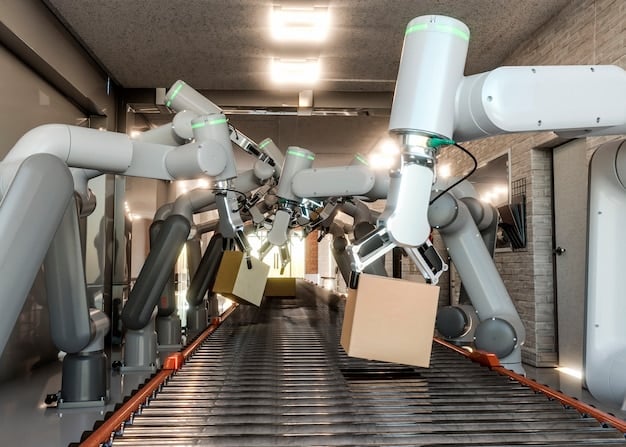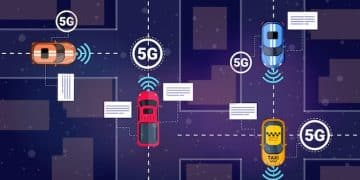Edge Computing in US Industries: Revolutionizing Data Processing

Edge computing is transforming data processing across US industries by bringing computation and data storage closer to the source of data, enabling faster insights, reduced latency, and improved security.
As US industries increasingly rely on real-time data processing, edge computing: revolutionizing data processing for US industries is emerging as a transformative solution. By bringing computation closer to the data source, edge computing minimizes latency, enhances security, and enables faster, more informed decision-making.
What is Edge Computing?
Edge computing represents a paradigm shift in how data is processed, moving away from centralized data centers to distributed nodes closer to the data source. This approach addresses the limitations of traditional cloud computing in scenarios demanding real-time responses and high bandwidth.
Decentralized Data Processing
Unlike cloud computing, which relies on transmitting data to remote servers for processing, edge computing brings the processing power closer to the end-user or device. This decentralization offers several key advantages.
Key Benefits of Edge Computing
Reduced latency is perhaps the most significant benefit, as it allows for near real-time data analysis and decision-making. Enhanced security is another crucial aspect, as sensitive data can be processed and stored locally, minimizing the risk of exposure during transmission.
- Lower Latency: Enables real-time applications and faster response times.
- Enhanced Security: Reduces the risk of data breaches by processing data locally.
- Reduced Bandwidth Costs: Minimizes the amount of data transmitted to the cloud.
In conclusion, edge computing offers a decentralized approach to data processing with significant benefits for industries requiring real-time insights and enhanced security.
Edge Computing Applications in Manufacturing
The manufacturing sector stands to gain significantly from edge computing, with applications ranging from predictive maintenance to quality control. Real-time data analysis enables manufacturers to optimize processes, reduce downtime, and improve product quality.

Predictive Maintenance
By analyzing data from sensors embedded in machinery, manufacturers can predict potential equipment failures and schedule maintenance proactively. This reduces unexpected downtime and minimizes production losses.
Quality Control
Edge computing enables real-time quality control by analyzing data from cameras and sensors on the production line. This allows manufacturers to identify defects early in the process and take corrective action immediately.
- Real-time Monitoring: Enables immediate identification of defects and anomalies.
- Reduced Downtime: Predictive maintenance minimizes unexpected equipment failures.
- Optimized Processes: Real-time data analysis drives continuous improvement.
Ultimately, edge computing empowers manufacturers to enhance efficiency, reduce costs, and improve product quality through real-time data analysis and predictive capabilities.
Edge Computing in the Healthcare Industry
The healthcare industry is another area where edge computing is making a significant impact. From remote patient monitoring to enhanced diagnostic capabilities, edge computing is improving healthcare delivery and patient outcomes.
Remote Patient Monitoring
Edge computing enables continuous monitoring of patients’ vital signs and health data, even in remote locations. This allows healthcare providers to detect potential health issues early and intervene proactively.
Enhanced Diagnostic Capabilities
By processing medical images and data locally, edge computing can speed up the diagnostic process and improve the accuracy of diagnoses. This is particularly valuable in emergency situations where time is of the essence.

- Improved Patient Outcomes: Early detection and proactive intervention lead to better health outcomes.
- Faster Diagnoses: Local data processing accelerates the diagnostic process.
- Enhanced Security: Processing sensitive patient data locally enhances data privacy and security.
In conclusion, edge computing is transforming the healthcare industry by enabling remote patient monitoring, accelerating diagnoses, and improving patient care.
Edge Computing in the Transportation Sector
The transportation sector is leveraging edge computing to improve safety, efficiency, and the overall passenger experience. From autonomous vehicles to intelligent traffic management systems, edge computing is playing a crucial role in the future of transportation.
Autonomous Vehicles
Edge computing is essential for autonomous vehicles, enabling real-time decision-making based on data from sensors, cameras, and radar. This allows vehicles to navigate safely and efficiently in complex environments.
Intelligent Traffic Management Systems
By analyzing data from traffic sensors and cameras, edge computing can optimize traffic flow and reduce congestion. This leads to improved commute times and reduced fuel consumption.
- Enhanced Safety: Real-time data analysis enables vehicles to make safe decisions.
- Improved Efficiency: Optimized traffic flow reduces congestion and fuel consumption.
- Enhanced Passenger Experience: Real-time data provides passengers with up-to-date information and personalized services.
Overall, edge computing is driving innovation in the transportation sector, enabling safer, more efficient, and more connected transportation systems.
Edge Computing in Retail and E-commerce
Retailers and e-commerce companies are using edge computing to enhance the customer experience, optimize operations, and drive sales. From personalized shopping recommendations to improved inventory management, edge computing is transforming the retail landscape.
Personalized Shopping Recommendations
By analyzing customer data in real-time, retailers can provide personalized shopping recommendations and offers, increasing customer engagement and driving sales.
Improved Inventory Management
Edge computing enables retailers to track inventory levels in real-time, ensuring that popular products are always in stock and minimizing stockouts. This leads to improved customer satisfaction and increased sales.
- Enhanced Customer Experience: Personalized recommendations and offers improve customer engagement.
- Optimized Operations: Real-time inventory tracking minimizes stockouts and improves efficiency.
- Increased Sales: Improved customer experience and optimized operations drive sales growth.
In summary, edge computing is helping retailers and e-commerce companies to deliver personalized experiences, optimize operations, and drive sales growth.
Challenges and Opportunities in Edge Computing
While edge computing offers numerous benefits, there are also challenges that need to be addressed. Security concerns, infrastructure management, and the need for skilled personnel are some of the key challenges facing the widespread adoption of edge computing.
Security Concerns
Securing distributed edge computing nodes can be challenging, as each node represents a potential attack surface. Implementing robust security measures and monitoring systems is crucial to protect edge computing infrastructure.
Infrastructure Management
Managing a distributed network of edge computing nodes requires sophisticated management tools and processes. Streamlining deployment, monitoring, and maintenance is essential for efficient edge computing operations.
- Addressing Security Concerns: Implementing robust security measures to protect edge nodes.
- Streamlining Infrastructure Management: Simplifying deployment, monitoring, and maintenance processes.
- Developing Skilled Personnel: Training and educating professionals to manage edge computing infrastructure.
In conclusion, while there are challenges to overcome, the opportunities presented by edge computing are immense, and addressing these challenges will pave the way for widespread adoption and innovation.
| Key Point | Brief Description |
|---|---|
| 💡 Reduced Latency | Enables faster data processing by bringing computation closer to the source. |
| 🔒 Enhanced Security | Processes data locally, minimizing the risk of data breaches during transmission. |
| 🏭 Manufacturing Impact | Supports predictive maintenance and real-time quality control, reducing downtime. |
| ⚕️ Healthcare Benefits | Facilitates remote patient monitoring and speeds up medical diagnostics. |
Frequently Asked Questions
▼
Edge computing is a distributed computing paradigm that brings computation and data storage closer to the location where it is needed, to improve response times and save bandwidth. Instead of sending data to a remote data center, processing is done locally.
▼
Cloud computing involves centralized data processing in remote servers, while edge computing distributes processing closer to the data source. Edge computing reduces latency and bandwidth, while cloud computing offers scalability and centralized management.
▼
The main benefits include reduced latency, enhanced security, lower bandwidth costs, and improved reliability. Edge computing enables real-time data analysis, minimizes data breaches, reduces transmission costs, and ensures continuous operation even when network connectivity is limited.
▼
Edge computing is beneficial across numerous industries including manufacturing, healthcare, transportation, and retail. It supports predictive maintenance, remote patient monitoring, autonomous vehicles, and personalized customer experiences.
▼
Conclusion
Edge computing: revolutionizing data processing for US industries presents a paradigm shift poised to reshape the operational landscape across diverse sectors. By decentralizing processing capabilities and bringing them closer to the data source, edge computing not only mitigates latency issues but also enhances security and optimizes resource utilization. While challenges such as security concerns and infrastructure management persist, the transformative potential of edge computing is undeniable, paving the way for smarter, more efficient, and more responsive systems that drive innovation and competitive advantage in the US market.





